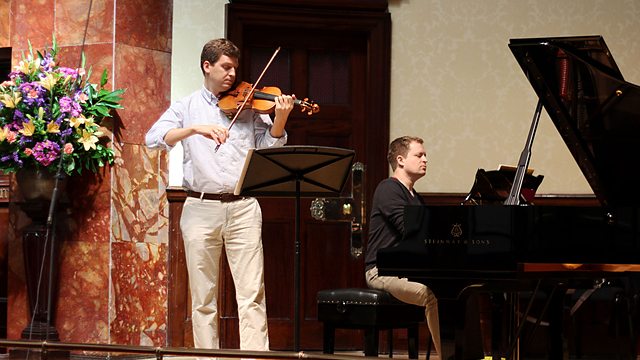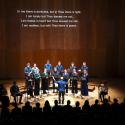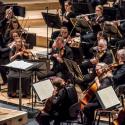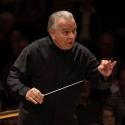Violinists either fathom the elusive heart and soul of Elgar’s music or miss the mark completely. Canadian James Ehnes, one of the most cultured soloists on the scene today, is the only one I’ve heard since Nigel Kennedy to make the Violin Concerto work in concert, in an equally rare total partnership with Elgarian supreme Andrew Davis and the Philharmonia. Last night he found the same emotional core in the Violin Sonata at the end of a colossal programme with a no less extraordinary but much less widely known companion, the American pianist Andrew Armstrong.
In their smart suits and ties, these two looked like men from the City. But they never had to apply the hard sell to their intelligent sequence. As in the last of Sakari Oramo’s Nielsen-centric concerts on Saturday, the concept was a quartet of works composed around the same time, in this case the hundred-year-old mark, hugely various so as not to overload a late romantic strain. While the Elgar Sonata was perhaps the work with the greatest personal depth, two movements either side of the interval emphasized an almost hallucinatory imagination both in the music and the performance.
 Armstrong (pictured right) has a musical personality to match the heavyweight Russians, producing an enormous sound when necessary, but always rounded, and always fine-tuned to the needs of his duo partner in flawless synchronicity. He needed the weight for the finale of Respighi’s B minor Sonata, a stunner after two not especially original movements: a Passacaglia which is to the violin-and-piano repertoire what the same form is to the conclusion of Brahms’s Fourth Symphony and clearly modelled on its inspiration. The violin, which Ehnes keeps tonally sweet and bright even when fullest of tone, rides the imposing double octaves and solemn chords of an amazing piano part, equally amazingly played.
Armstrong (pictured right) has a musical personality to match the heavyweight Russians, producing an enormous sound when necessary, but always rounded, and always fine-tuned to the needs of his duo partner in flawless synchronicity. He needed the weight for the finale of Respighi’s B minor Sonata, a stunner after two not especially original movements: a Passacaglia which is to the violin-and-piano repertoire what the same form is to the conclusion of Brahms’s Fourth Symphony and clearly modelled on its inspiration. The violin, which Ehnes keeps tonally sweet and bright even when fullest of tone, rides the imposing double octaves and solemn chords of an amazing piano part, equally amazingly played.
Then, after much needed liquid refreshment, came the water-music of the first in Szymanowski’s trilogy of Myths as Artemis transforms the nymph Arethusa into a fountain. The glassy liquidity is there in the piano from the start, but the violin has equal claim in melody eventually muted, plus a quietly spectacular double-stopping plunge at the end: hyper-Debussyan so-called impressionism about 10 years late – composed, in fact, just before Debussy wrote his own much more epigrammatic Violin Sonata in 1916-17, an eloquent and phenomenally consonant start to the evening. We’ve just witnessed at the Royal Opera how Szymanowski’s King Roger of a decade later is almost a touch too late stylistically speaking; yet in both his works a personal voice occasionally flashes out, filtered through mythological distance and a good shot at metaphysics. Many of us got to know the Myths through a celebrated recording by Kaja Danczowska – where is she now? – and Krystian Zimerman; Armstrong was the famous Polish pianist’s equal in a complex role.
 Still, we needed the Elgar for a confessional that always slips shyly away from total self-revelation. What an extraordinary first movement he came up with in 1918, starting with almost excessive self-confidence, dwindling by degrees to introspection in more original double-stopping. This is where you know whether you’re witnessing the ideal interpreters, and in leaving us on the edge of tears, the duo (pictured above in rehearsal yesterday, courtesy BBC) got it absolutely right.
Still, we needed the Elgar for a confessional that always slips shyly away from total self-revelation. What an extraordinary first movement he came up with in 1918, starting with almost excessive self-confidence, dwindling by degrees to introspection in more original double-stopping. This is where you know whether you’re witnessing the ideal interpreters, and in leaving us on the edge of tears, the duo (pictured above in rehearsal yesterday, courtesy BBC) got it absolutely right.
There was more evasiveness in the featherlight dance steps breaking out in the equally personal central Romance, and a total elevation in the hard-won ebullience of the finale. In all this Ehnes never produced a less than pitch-perfect note, and every phrase lives with him, without showmanship or forced rhetoric. The encores were a perfect pair: from what the violinist described as a vast choice of more music composed circa 1915, we heard a quirky, very brief Mazurka by anniversary composer Sibelius and a typical stroke of miniature genius from Ravel actually composed in 1922, the Berceuse sur le nom de Gabriel Fauré, in which Ehnes and Armstrong rounded off a singular simplicity with a final supernatural sleight of hand, flawless to the last.














Add comment